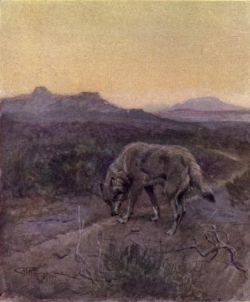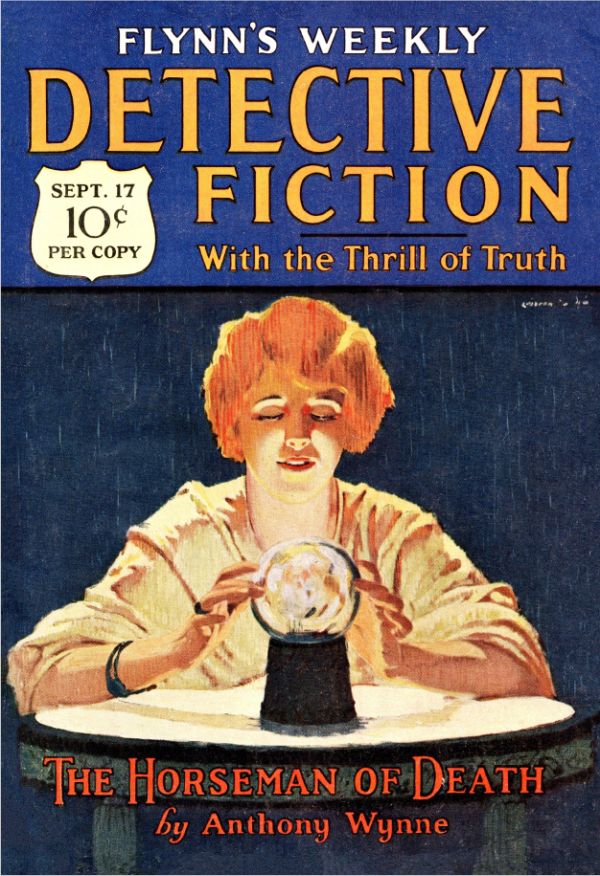The magazine begun in 1924 was by mid-1927 being published under the title shown above, though within a year it would be renamed once more, to its most familiar title, Detective Fiction Weekly, which it would retain until 1941. The September 17, 1927, issue contains the usual array of long and short fiction, including serial parts, as well as fact-based articles. The contents are as follows, with my comments.
- Novelettes
- “The Crooked Trail,” by Walter Archer Frost. In this thriller starring series character Ruggles, the master detective and his secretary, the narrator, battle a clever fiend who uses Amazon fever to kill but is also willing to try with poison gas. Fun stuff, even if not particularly surprising; recommended.
- “Not,” by Frank Price. Insurance investigator Charley Barrow gets involved when a well-insured author is slain, as the death is covered by a double-indemnity clause unless it can be shown that the beneficiary was somehow involved in the crime, but matters become more complicated when the killer strikes again. The only clue in each case is a note stuck in the victim’s pocket stating “There Is” and nothing more. The explanation for the crimes seemed a bit too far-fetched to be a satisfying solution, albeit it did provide a justification for the title of the novelette; mildly recommended.
- Short Stories
- “The Lightning Returns Co.,” by Valentine (Archibald Thomas Pechey). The second of six “episodes” finds the vigilantes employing a campaign of harassment &mdahs; chiefly consisting in the constant repetition, in varying circumstances, of a sum that represents life savings lost in a fraudulent investment. This was an enjoyable enough story, however implausible; recommended.
- “What’s the Law Among Friends?” by Louis Weadock. A new district attorney goes after a murderer who just happens to be the political power responsible for his appointment. What will ensue? The story is long on setup but abrupt and unsatisfying in its conclusion; not recommended.
- “Rabbits,” by Austin F. Roberts. Roberts contrives an unusual tale about an unpleasant crook, a thief and killer, who despite his hardness attempts to set his aging father up with a farm (hence the title) so as to keep him out of a nursing home. I never really warmed to it; mildly recommended.
- “The Splitting Edge,” by Edward Parrish Ware. Arkansas Ranger Jack Calhoun (a long-running series character) solves a killing thanks to the clue provided by the double-bitted axe that was the murder weapon, and specifically because the two edges were sharpened differently. I’d be happy to read more of this character; recommended.
- Serials
There are two serials, which I have not read as I do not have all the relevant issues: Part 1 (of 5) of The Horseman of Death, by Anthony Wynne, featuring his series detective Dr. Eustace Hailey, and Part 4 (of 5) of Defenders of the Law, by Mansfield Scott, which likewise has two series characters — Malcolm Steele and Dizzy McArthur. - Fact-Based Articles
These include “Three Men in Gray,” describing a murderer’s attempt to put over a fake story about an attack; “Haunts of the Invisible [No. 3],” an article on apparitions; “Deacon Brodie,” concerning the life and career of Edinburgh’s famed 18th-century master criminal; “The Elusive Giant,” on a career criminal who adopted the alias Franz von Veltheim and operated around the turn of the 20th century in Europe, America, and South Africa; and “Case No. 57883-D,” about the pursuit of three criminals who staged a murderous (yet unsuccessful) robbery of a Southern Pacific train near Siskiyou, Oregon. Though generally these were of some interest, my preference is for the fiction.


One thought on “Wednesday Pulp: Flynn’s Weekly Detective Fiction, September 17, 1927”